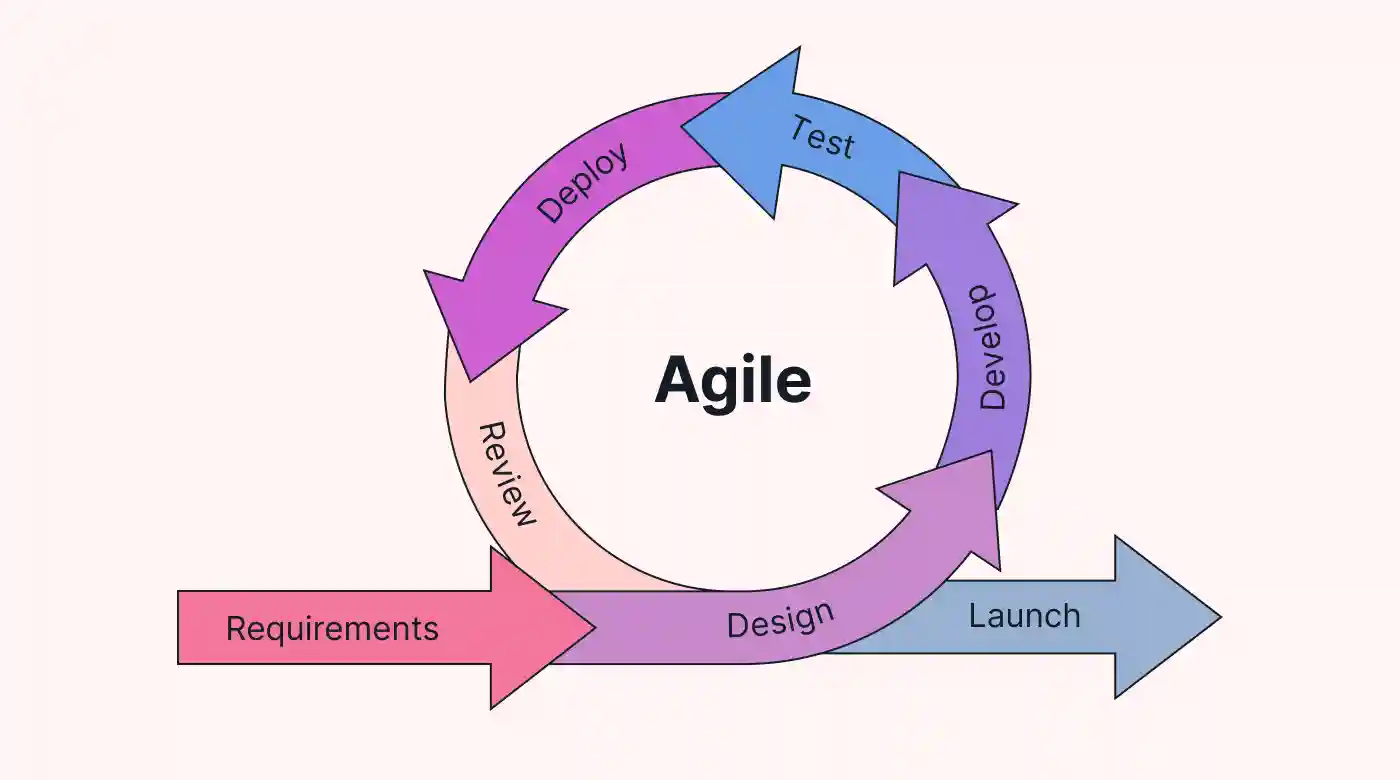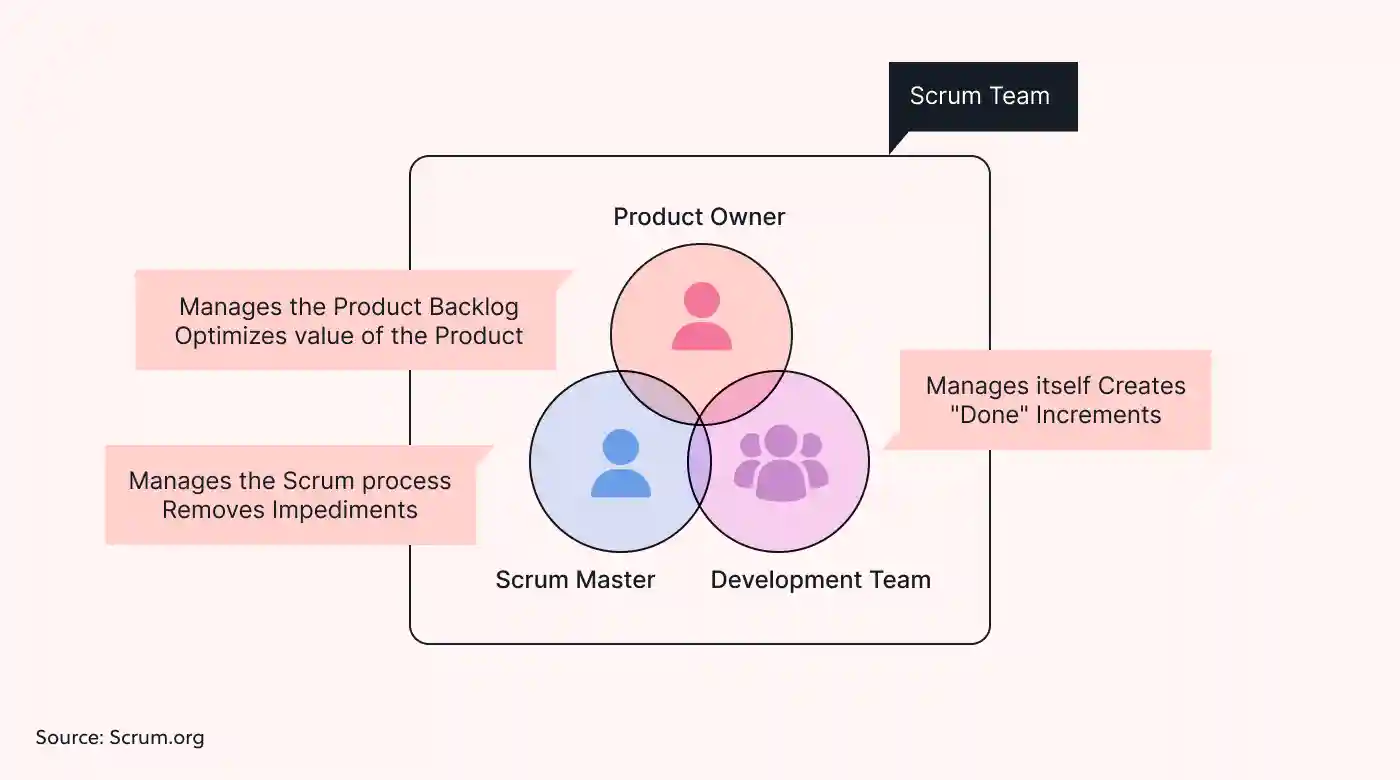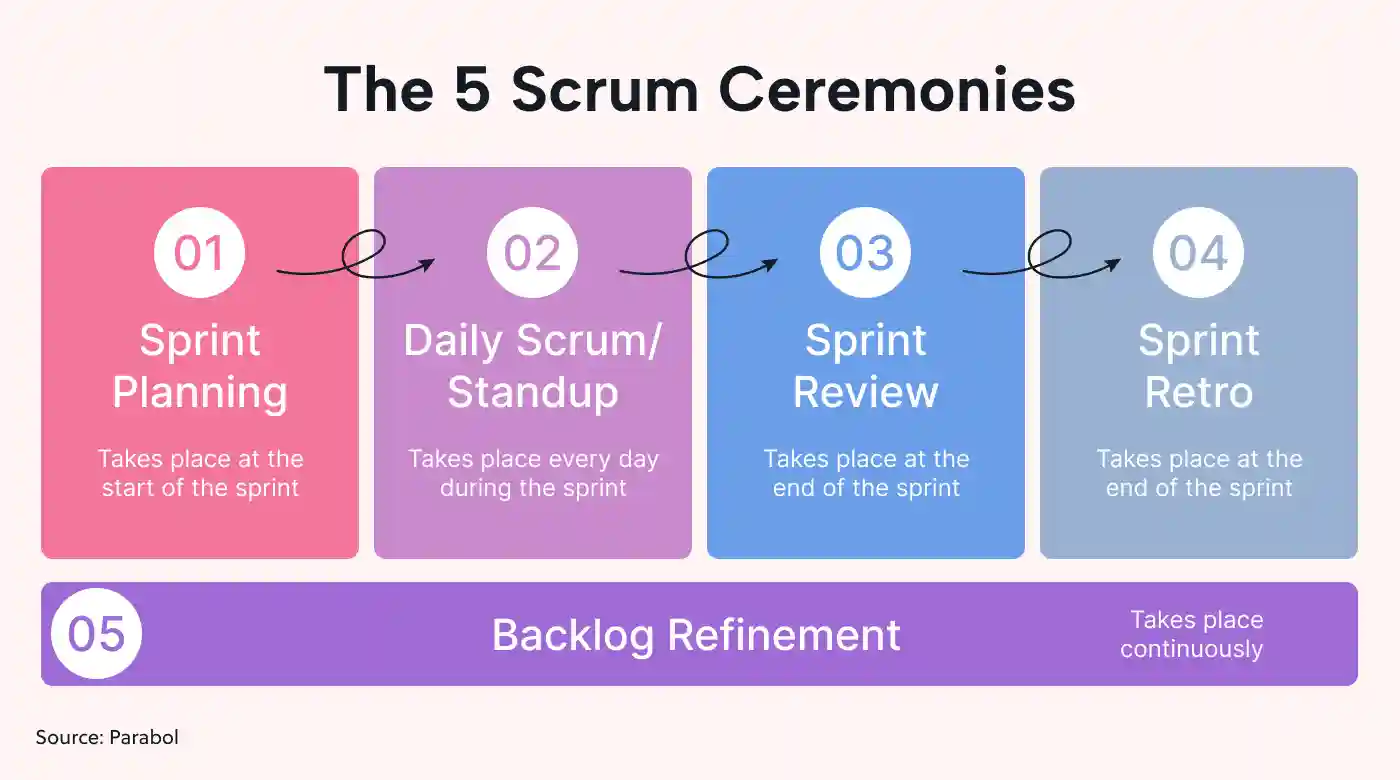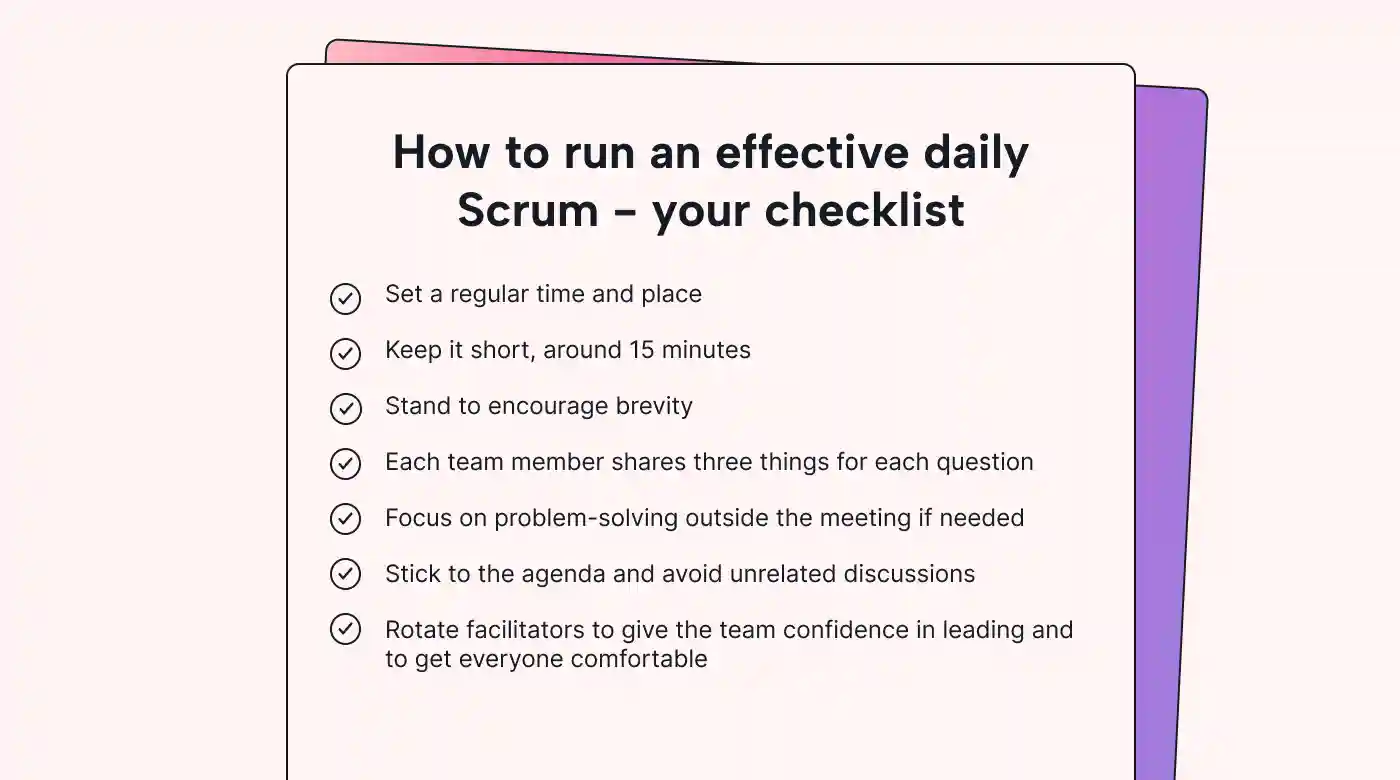If you’re sick of chasing up task status and project progress updates, adding a daily meeting to your schedule might make you cry.
But what if we told you that a recent study by Broadcom shows that Agile teams provide 250x more quality while using the scrum framework?
So, if it’s agility and more transparency in your project management that you’re after, read on.
In this article, we’ll show you:
- What daily stand-ups are and how they fit into the Scrum framework
- How you can use Agile methods to improve your delivery speed while increasing the quality of work
- Plus, how to run an effective daily standup that saves your development team time.
What is Agile?
Before we can dive into the daily standup meetings, we need to touch on some fundamentals.
So, first of all, what is Agile in managing work?
Agile is a project management methodology about continuous improvement and flexibility in managing your work. It was developed to be adaptable enough for the fast delivery of a minimum viable product (MVP) in software development but is now used in all kinds of projects, from ad campaigns to submarine building.
 |
There are four core values that “power” Agile:
- Individuals and interactions over processes and tools
- Working software over comprehensive documentation
- Customer collaboration over contract negotiation
- Responding to change over following a plan
Furthermore, there are 12 principles that go with the four core values. These are outlined in the Agile Manifesto
Agile is more like a philosophy than a set of instructions that you can follow to manage your projects. This is where frameworks come in, to provide the essential components that help you apply the Agile principles to specific processes. Scrum is one such framework.
What is Scrum?
Scrum, an extremely popular framework in the world of Agile, takes its name from the rugby term for short plays and is like having a playbook for implementing Agile in your business. It breaks down your project into manageable chunks (or sprints). These sprints are like playing a series of short, focused matches rather than one long game. First, you refine your project strategy and then execute your work in short, two-week bursts.
Better collaboration within your project team is achieved through team huddles. Adaptability calls for a stand-up when needed, and continuous improvement is tweaking your game plan as you go. The goal here isn't just winning at the end of the project but scoring points with each play, or sprint.
And just like in a rugby team, every player in your project team will have a specific position to play or a set role.
Scrum roles
To implement Scrum, there are set roles to assign outside of your core team's usual functional roles (such as graphic designer, project manager, or developer team).
 |
These scrum roles are:
- Scrum master, who facilitates the scrum process, acts as the team leader and removes obstacles.
- The product owner, who represents your stakeholders (like your users, clients, or customers), defines the overall project vision and prioritizes work items in the backlog.
- The development team, which is a self-organizing group of project team members that deliver these short increments of work.
For example, in a marketing agency, the copywriter might also be the scrum master, responsible for their usual work but also for making sure everyone is working backlog items on the task board and implementing scrum correctly.
Your project manager might be your product owner (they’ll manage your backlog or “to-do list”), while everyone else working on the project is the development team.
These roles contribute to the scrum ceremonies that are the structural backbone of the scrum framework.
Scrum ceremonies
Also known as Scrum events, Scrum ceremonies are how feedback and continuous improvement are constantly encouraged throughout the entire lifecycle of your project. Think of scrum ceremonies as a regular team meeting format in a journey to build something valuable.
Let’s look at these five ceremonies in terms of a long road trip:
- Sprint planning (road mapping): Imagine planning a road trip. The team decides the route (tasks to be done) for the upcoming journey (sprint) and packs their bags (commits to work) accordingly.
- Daily stand-up/daily scrum (pit stop): Similar to a daily car check before hitting the road. Team members quickly discuss progress and hurdles and adjust plans if needed, making sure everyone’s on track toward the destination.

- Sprint review (destination checkpoint): Reaching a checkpoint in the trip, the team shows off what they've achieved (the car’s performance) to stakeholders (fellow travelers) for feedback.
- Sprint retrospective (lessons learned): After the checkpoint, travelers (the team) discuss what went well (scenic spots) and what could be improved (bumpy roads) for the next trip.
- Backlog refinement (preparation for the next journey): Carefully mapping out new destinations, finding interesting places to explore (new tasks to tackle), and ensuring the vehicle (project) is ready for the upcoming adventures. It's the behind-the-scenes work to ensure the next road trip (sprint) is as rewarding and efficient as possible.
Each event serves to foster team dynamics and make sure your team can remain adaptable, much like checkpoints and detailed discussions refine your travel plans to improve later trips.
And just like a compelling journey needs a map, Scrum has documentation or artifacts to make the journey as streamlined as possible.
Scrum artifacts
The Scrum artifacts reflect the value of the work that needs to be completed. While these might be documents, they can also be intangibles, like objectives or goals. According to Scrum.org, these artifacts are a commitment to quality and are as follows:
- For the product backlog, the Scrum artifact is the product goal.
- For the sprint backlog, it’s the sprint goal.
- For the increment (or the sprint), it’s the definition of done (a.k.a, what does success look like?).
These commitments are best documented as SMART goals that can be measured so everyone knows what success looks like for both the backlogs and the completion of each sprint.
When everyone knows what success looks like, it’s easier to agree as a team that you have reached the right level of quality and value to determine the sprint (or the project) has been completed.
Why is it called a daily scrum meeting?
With that said, you've probably figured out what a "daily scrum" is, but just in case, this everyday meeting refers to the daily stand-up meeting you'll have with your team throughout your sprints. "Daily" signifies its frequency, happening each workday, while "scrum" is all about teamwork and unity.
In your daily scrum (or standup) you'll have a brief meeting where the team discusses progress, plans for the day, and any obstacles they face.
While you might be thinking that this is a meeting that's limited to Agile or scrum settings, businesses using more traditional project management approaches use the standup daily to keep everyone on track and even apply a little social pressure. I mean, who wants to be the only team member with the same to-dos from Monday on their list on Friday?
Daily standups can reduce longer status update meetings and help keep your team focused with the most important tasks always kept front of mind.
How do you deliver the best possible daily scrum and why does it matter?
The daily scrum matters because it helps the team work together better. It’s as simple and as complex as that. These daily standups are a great communication opportunity, encourage the team to find and solve problems quickly and make sure everyone is heading in the same direction. They can be especially helpful for remote teams.
But you can’t just throw daily scrum meetings into the mix without a plan! After all, if you don’t get it right, you’re only adding another, separate meeting to an already busy schedule, and your team won’t thank you for it.
So, how can you master your team’s daily standups?
Timebox it
Keep them short and focused, aiming for 15 minutes or less to encourage brevity and staying on track. This isn’t time for catch-ups about everyone’s weekends or debriefing on the latest episode of The Kardashians. Keep them short, sharp, and shiny for everyone’s benefit - including yours.
Stick to the three questions
Don't confuse your daily standups for status meetings where everyone discusses the overall project at length. These also aren't times to solve problems. You want to understand where there are issues in getting individual tasks done, but the goal is to take these issues offline and solve them outside of meeting time.
To keep everyone focused, each person should answer these three questions only, then move on:
- What did you work on yesterday?
- What will you work on today?
- Are any roadblocks or issues keeping you from completing a specific task?
Note the "specific" here. This isn't the time to vent about overall project progress or complain, but to address the small blocks coming up daily.
For example, a standup roadblock might sound like “I can’t complete the image because the copy isn’t completed” vs. “So and so works too slow, and the client took too long to approve the wireframe and I ran out of time because of xyz.”
Keep it relevant
Focus lengthy discussions on tasks related to achieving the sprint goal, while mindfully avoiding detailed problem-solving during the meeting. Note any obstacles or roadblocks but don’t address these until after the stand-up.
This helps you avoid extended problem-solving discussions during meetings when everyone should already be hard at work.
Stand up, literally
Standing can help keep the meeting brief and focused while encouraging active participation.
Everyone deserves a chance to speak, so stop anyone who goes over time or interrupts others while keeping the meeting concise .
If discussions extend beyond the allotted time, address them separately to respect everyone’s time.
Encourage engagement
Make sure everyone participates, sharing updates and actively listening, as it's an entire team discussion, not solely for the Scrum Master or Project Manager to voice their concerns.
If one person speaks more than others, you could tactfully bring in a silly word that anyone can use to call out too much talking, like "pickle." Everyone can agree that when they hear this word, it's time to move on, and because the word has no other connotations, it's agreed that it's nothing personal. (Plus, everyone gets a laugh or two in.)
Active participants make Scrum meetings so powerful.
Adapt and improve
Regularly review the meeting's effectiveness and adjust the format if needed to enhance productivity and team collaboration. This shouldn’t be about making meetings dry, or shorter than they need to be, but about making them as effective as possible so everyone can get the help they need, then get back to work.
Three pro tips to master your daily standups
So you’ve decided to try standups, but how do you make the most of them with your team?
1. Set a time limit and stick to it
- Respect everyone’s time and keep it punchy
- Use a stopwatch if you have to
- Stop anyone who interrupts or moves on to other topics that aren’t relevant - remember “pickle!”
2. Rotate facilitators to provide leadership opportunities
- Rather than having the same person run the meeting every time, rotate who runs the meeting.
- This helps those less keen to get involved take ownership of the process.
- It can also help those who are more shy or get less time in the spotlight take a step in their skills development by speaking to the group and even having to stop those more boisterous team members from talking too much.
3. Manage all of the notes and action items in an AI-driven project tool
- Don’t fall into the trap of taking action within the meeting
- Use your project management tools to auto-schedule your standups for everyone
- Then keep all meeting notes and action items in the same place so they can be acted on outside of the meeting
Let smart scheduling help your standup game.
Level up your daily standups with Motion
The thought of a daily meeting might make you feel overwhelmed. However, standups can save you hours in unnecessary meetings if done correctly. Give your team the autonomy to self-manage because you’ll know quickly if there is an issue, who is completing their daily task, and who isn’t all from a week of standups.
Plus, you can manage it all with the help of your very own project-managing AI assistant: Motion.
Get more oversight with fewer meetings while Motion manages the action items! Win-win.

Haylee is a versatile writer with ten years of experience. With a background in marketing and writing for large SaaS companies, Haylee brings her passion for the written word to diverse projects ranging from blog posts and ebooks to direct marketing campaigns.





